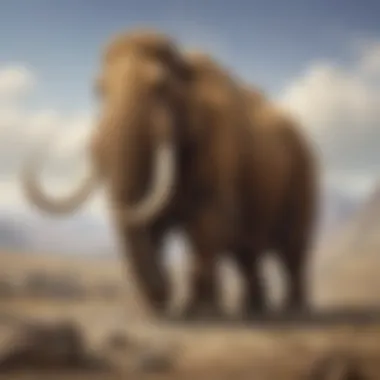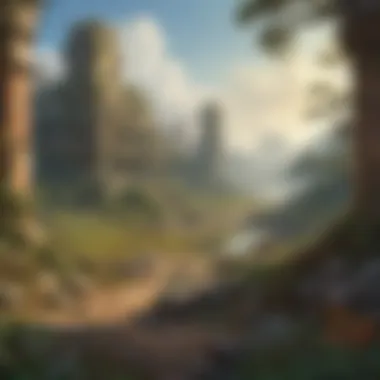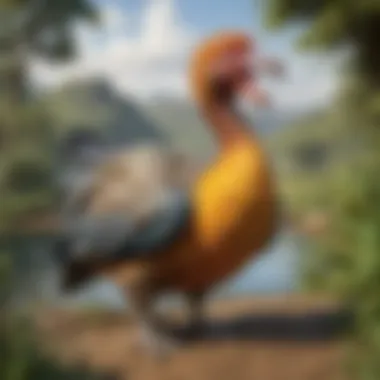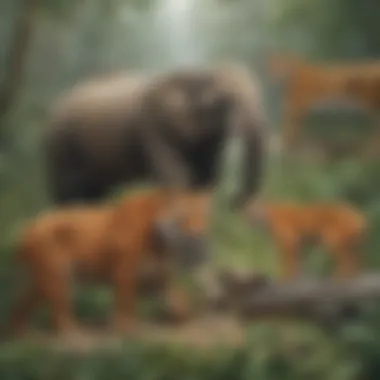Species That Have Gone Extinct: A Comprehensive Analysis


Intro
The extinction of species represents a significant chapter in the history of Earth. Each vanished organism is a reminder of the intricate tapestry of life that once existed. This topic not only prompts reflection on past ecological occurrences but also presents critical lessons for present and future biodiversity efforts. Understanding the factors contributing to extinction enriches our comprehension of current environmental challenges.
As we delve into various aspects, we highlight not just the causes of extinction such as climate change, habitat destruction, and human activities but also explore the existential implications these losses carry. Our journey through this subject will include notable case studies and underscore the importance of conservation initiatives in combatting the biodiversity crisis.
Understanding Extinction
The concept of extinction involves the dying out of a species, and often signifies severe ecological repercussions. When a species becomes extinct, it leads to undistributed consequences across ecosystems. The removal of an organism can disrupt food chains and affect the survival of other species. In some instances, cascading effects might lead to further extinctions.
Alterations to the ecosystem due to anthropogenic factors, including industrial growth and deforestation, have bred a dichotomy between nature and human progress. This not only compromises numerous species but unexpectedly burdens human populations with ecological instability.
Causes of Extinction
The role humans play cannot be overstated. Several factors precipitate the end of species. The main contributors include:
- Habitat Destruction: As landscapes transform for agriculture or urban development, natural habitats diminish.
- Pollution: Contaminants seep into ecosystems, devastating wildlife through toxic exposure.
- Overexploitation: Unsustainable hunting, fishing, and resource extraction accelerate the decline of species.
- Invasive Species: Non-native species may overshadow native populations, diminishing their chances of survival.
- Climate Change: Fluctuating climate patterns hinder species’ ability to adapt or migrate.
Philosophically, extinction mirrors a disconnect between humanity and the environment, emphasizing a need for a realigned perspective on Earth's multifaceted biota.
Conversations on Conservation
Conservation efforts emerge as efforts to preserve remaining biodiversity and restore ecosystems affected by past harms. Global initiatives aim to safeguard endangered species while instilling practices fostering environmental stewardship. This highlights an active social dialogue concerning ecological responsibility and intergenerational accountability.
Such efforts include protecting habitats with laws and regulations, supporting breeding programs for endangered species, and raising awareness about environmental issues. By valuing these initiatives, we educate society on the urgency to halt future extinctions.
Intro to Extinction
Understanding extinction is essential in order to grasp its effects on our ecosystems and biodiversity. This section brings forth a foundational aspect of biologocial reality—recognizing extinct species. This awareness is crucial not just for educational purposes, but also for guiding future conservation efforts. Extinction represents a loss not only of species but also multi-faceted connections a species has with its ecosystem.
Defining Extinction
Extinction occurs when a species ceases to exist. This can happen through various gradual processes or sudden events. Once a species is gone, it is irreversible; the impact can be profound on ecological diversity and function.Definition can also include subspecies or local varieties, emphasizing how sensitive certain groups are to ecological changes or human intervention.
Extinction should be viewed as an immediate alarm for humanity as well. To see the demise of a species often indicates failures in management of ecosystems or environmental neglect. The process of extinction can occur due to natural causes, but often human influences amplify these losses. Some of these factors can be discussed in later sections.
The Importance of Biodiversity
Biodiversity is a term encompassing the vast array of life forms on Earth, including flora, fauna, and microorganisms. High biodiversity leads to resiliency within ecosystems, enhancing their ability to tolerate changes and recover from disturbances. When species go extinct, this balance tips, leading to weaker ecological systems.
The complexity in ecosystems functions through intricate relationships, where every species contributes in unique ways. Loss of even one species can ripple through the food web effecting numerous species negatively. Schools of thought maintain that conserving biodiversity is key for sustainability, meaning an investment in the biodiversity approach can lead us to solutions regarding current conseration challenges.
A strong foundation in biodiversity knowledge enables individuals and communities to prioritize efforts in conservation. This can be beneficial for educational efforts across different age groups, especially in encouraging younger generations to contribute positively. Understanding these points creates space for more informed discussions as society approaches changex impacting biological variety.
"The continued extinction of species and their association with human behavior is alarming and calls for serious attention to our ecological practices."
This section builds the framework to examine life's vast tapestry, setting the basis for exploring historical events, modern challenges, and future strategies.
Historical Overview of Extinct Species
Understanding the historical overview of extinct species is crucial for illuminating the patterns and dynamics that lead to biodiversity loss. This section sheds light on the different phases of extinction and what they mean for ecosystems overall. Recognizing the timeline of extinctions provides context to current conservation efforts and helps us grasp the vastness of lost biological diversity. By examining prehistoric extinctions and mass extinction events, readers can better appreciate how ecological balance has shifted dramatically throughout Earth's history.
Prehistoric Extinctions
Prehistoric extinctions refer to the significant loss of various animal and plant species prior to human intervention. These extinctions provide a glimpse into the evolutionary processes that sculpt ecosystems over millions of years. Many prehistoric species, such as the woolly mammoth and saber-toothed tiger, faced challenges from changing climates, natural disasters, and competition among emerging species.


Several species disappeared during this time due to gradual climate changes. The end of the last Ice Age, a period approximately 11,700 years ago, created drastic shifts in habitat suitability, pushing many species past the threshold of adaptability. In contrast, some extinctions were abrupt, causing tremendous ecological disruption. Recognition of these events emphasizes how ecosystems can rapidly evolve, yet also reiterates the vulnerability of these systems.
Mass Extinction Events
Mass extinction events highlight serious failures of ecosystems resulting in vast numbers of species disappearing within a relatively short time. These events are more than just points of interest in geological history; they warrant further examination of their causes, effects, and connection to current biodiversity crises.
Causes of Mass Extinctions
The causes of mass extinctions vary and often stem from a blend of natural phenomena and drastic shifts in environmental conditions. Notable factors assembling these causes include massive volcanic eruptions, like the one that occurred during the Permian-Triassic extinction, and significant asteroid impacts, such as the one at the Cretaceous-Paleogene boundary. These incidents disrupted global climates, caused habitat destruction, and drastically altered food webs. Identifying the causes is essential because they reveal how interconnected Earth’s systems are. Their collective significance demonstrates how seemingly separate ecological components can have transformative impacts on global biodiversity.
The Role of Climate Change
Climate change plays a double role in mass extinction events, acting as both a direct factor precipitating extinctions and as a backdrop that exacerbates other environmental stresses. Global temperature fluctuations and shifts in weather patterns can make already vulnerable species face greater challenges. Understanding climate change helps explain how living organisms continually navigate emerging pressures. It serves a crucial narrative for educational and conservation-oriented agendas. The lessons derived from previous mass extinctions inform current policy considerations and inspire active discussions among conservationists today, considering that habitats and species have long been subject to such pressures.
"Studying past extinctions not only enables us to understand nature’s devastating norms but also to apply this knowledge in fostering change in conservation narratives representing our contemporary world."
Consolidating this understanding engages us in a vital conversation about sustainability and custodianship of habitats threatened by climate change, overexploitation, and other human activities. It stimulates a question often asked today: what can we learn from histories long since settled, to govern futures yet to unfold?
Anthropogenic Factors Contributing to Extinction
The impact of human activities on extinction rates among species cannot be understated. As the dominant species on the planet, our actions significantly influence the health and stability of ecosystems worldwide. Understanding anthropogenic factors is critical in recognizing how our decisions steer the futures of countless species. Addressing these factors in detail can highlight ways in which human behavior can be altered for a more sustainable relationship with the natural world.
Habitat Destruction
Habitat destruction stands out as one of the primary drivers of species extinction. Urbanization, agriculture, and deforestation have all contributed to the loss of natural habitats. When forests and wetlands are cleared for development or farming, the delicate balance in which species thrive is disrupted.
The fragmentation of habitats creates isolated populations. When these populations cannot interbreed effectively, it leads to a decrease in genetic diversity. This genetic bottleneck can inhibit a species' ability to adapt to changing environmental conditions, making them more susceptible to extinction. It is essential that conservation efforts include strategies to protect and restore habitats. This ensures the preservation of the biodiversity that makes up our ecosystems.
Overexploitation of Resources
The overexploitation of resources poses a significant threat to multiple species across the globe. This happens when species are hunted, fished, or harvested at unsustainable rates. Notable examples include overfishing certain populations of fish, poaching wildlife for their parts, like tusks or furs, and overharvesting plants for food and medicine.
Such practices drastically undermine local ecosystems. Economic incentives often encourage overexploitation, leading to the short-term gain that neglects the long-term viability of species. Conservationists argue for sustainable practices. For instance, managing fisheries with appropriate quotas can help to restore fish populations. Conservation education is vital in guiding communities to balance their livelihoods with ecological stability.
Prelims of Invasive Species
Human activity has often led to the introduction of invasive species into ecosystems that can dramatically alter the balance. Invasive species usually lack natural predators in their new environments. They multiply quickly, causing distress to native species by competing for resources, spreading disease, or even preying on them.
One major impact of invasive species is that they can lead to the decline or extinction of native species. For example, the introduction of the brown tree snake in Guam resulted in the eradication of many native bird species. Addressing the invasive species problem requires much effort, such as preventive protocols at the ports and active management in ecosystems to eliminate established invasives.
Notable Extinct Species
Understanding notable extinct species illustrates the complex dynamics of ecosystems and the impact of various human-influenced factors. Each of these species offers insights into reasons behind extinction and serves as a reminder of the fragility of biodiversity. By examining their stories, we can extract essential lessons that inform contemporary conservation strategies. Learning about these specific cases encourages a healthy respect for the remaining biodiversity and highlights the urgent need for responsible management of natural resources.
The Woolly Mammoth
The Woolly Mammoth, a massive creature that roamed the Earth during the last Ice Age, serves as a symbol of prehistoric animal life. These majestic mammals could weigh up to six tons and were known for their long, curved tusks and thick fur, adaptations to cold environments.
Their extinction, around 4,000 years ago, is often attributed to a combination of climate change and human hunting. As the planet warmed, their habitat diminished. Additionally, the overhunting by early humans added pressure on these already vulnerable creatures.
Understanding the extinction of the Woolly Mammoth helps emphasize the impact of climate change on larger species.
The Dodo Bird
The Dodo Bird is infamous for being one of the first species documented as being driven to extinction due to human activities. Native only to Mauritius, this flightless bird was about one meter tall. Arriving in the 17th century, European sailors hunted dodos for food, while invasive species brought by settlers, such as rats and pigs, destroyed their nests. The last confirmed sighting of a dodo bird was in the late 1600s.
The tale of the dodo highlights how a lack of understanding of the ecological balance can result in irreversible consequences. This unfortunate extinction urges careful consideration of human actions on wildlife and encourages protective measures for endangered species.


The Passenger Pigeon
Once abundant in North America, the Passenger Pigeon could be spotted soaring in flocks of billions. This species was thought to be indestructible, but by the early 20th century, it faced extinction due to massive hunting and loss of habitat.
From being one of the most numerous species in the continent to extinction, the Passenger Pigeon went from billions to being declared extinct in just a few decades. The last known passenger pigeon, named Martha, died in captivity in 1914.
The decline of this species serves as a stark cautionary tale about human greed and reckless exploitation of natural resources, reinforcing the need for sustainable practices in wildlife conservation.
The Tasmanian Tiger
The Tasmanian Tiger, or Thylacine, lived in Australia and Tasmania. This carnivorous marsupial was more wolf-like in appearance, featuring stripes across its back, leading to its common name. Habitat destruction, hunting, and introduced diseases led to its decline in the 20th century.
The last confirmed Tasmanian Tiger died in captivity in 1936, marking the end of this unique species. Renowned for its elusive nature, details about their behavior and ecology remain incomplete, providing an essential case for continuing studies in environmental science. The Tasmanian Tiger reminds us of our duty to protect existing wildlife before we lose unique species forever.
Ultimately, the stories of these notable extinct species encourage critical thinking about our role in ecosystems. As we reflect on their lessons, we are faced with the vital responsibility of ensuring the future survival of the remaining species on our planet.
Consequences of Extinction
Extinction has far-reaching consequences that impact not just the species that disappear but also the ecosystems and human societies at large. Understanding these consequences goes beyond mourning the loss of individual species; it reveals how interconnected life is on Earth. This awareness can facilitate more effective conservation strategies and underscore the urgency of protecting remaining biodiversity.
Ecological Impact
The ecological effects of extinction are profound and can fundamentally alter ecosystems. When a species ceases to exist, it often leads to significant changes in food web dynamics. For instance, herbivores may flourish unchecked, while predators that relied on the extinct species as food can suffer from food shortages.
- Loss of Predators: The absence of higher trophic levels may result in overpopulation of certain species. This can choke habitats and limit resources.
- Flora Changes: Declining species can not only disrupt animal populations but also the plants that depend on them for pollination or seed dispersal.
Furthermore, missing species can impact ecosystem functions like nutrient cycling and habitat structure. A decline in diversity may decrease resilience to environmental changes, making ecosystems fragile and vulnerable.
Important Note: The ramifications of extinction extend to humans as well, influencing agriculture, medicine, and economies.
Loss of Genetic Diversity
Genetic diversity is important for a population's resilience to disease, climate change, and environmental stresses. When species become extinct, they take their unique genetic variations with them.
The loss of genetic diversity brings forth several risks:
- Reduced Adaptability: Populations with lower genetic diversity find adaptation to environmental changes difficult. This weakness threatens not only the species but potentially those that depend on them for ecosystem services.
- Disease Vulnerability: Pathogens evolving over time could overcome the immunity of species with low genetic diversity, putting them at higher risk.
Such disparities render ecosystems unbalanced, leading to a loss of species resilience. Beyond ecosystems, the extinction of species can also incapacitate medical advancements that rely on compounds derived from a variety of organisms.
Conservation: Lessons Learned from Extinct Species
Conservation lessons learned from extinct species hold significant value. They shed light on the direct and indirect consequences of human actions on biodiversity. Knowledge gained is essential for shaping future conservation strategies and policies.
The Importance of Conservation Efforts
Conservation efforts are crucial for protecting and preserving remaining biodiversity. The extinction of a species is often irreversible. Thus, we must understand why conservation is vital. Protecting species can also mean maintaining healthy ecosystems.
- Preservation: Conservation efforts aim to safeguard habitats and ecosystems.
- Ecosystem services: Both plants and animals contribute to ecosystem stability Andbalance.
- Community engagement: Involving local communities can lead to effective conservation initiatives.
At times, conservation helps us discover new species as well. "Every time w learn from what was lost, we gain insight into how to protect what is left," shared a prominent ecologist.
Restoration Ecology
Restoration ecology focuses on rehabilitating damaged ecosystems. This approach seeks to regain the original functions of environments where species have gone extinct. Often, restoration achieves significant ecological recovery. Restoration can take several forms including:


- Reforestation: Planting native trees to restore forest habitats.
- Wetland restoration: Reconstructing wetland areas can revitalize entire habitats.
- Reintroduction: Some areas successfully reintroduce extinct species through captive breeding.
Restoration ecology considers historical conditions before human interference predisposed healthy ecosystems. The effectiveness greatly depends on how closely the goal aligns with the original ecological standards. As a result, restoration efforts learn from each species extinction to prevent further losses while improving ecosystem health.
Contemporary Implications of Extinction
Understanding the contemporary implications of extinction provides critical insight into how current biodiversity crises are affecting our ecosystems today. Extinction is not merely a past event; it continues to unfold, often as a direct result of ongoing human activities. The ramifications of species loss extend far beyond individual organisms, influencing entire ecosystems and disrupting natural processes that have evolved over millions of years. Our engagement with this topic is imperative as we confront the challenges these extinctions pose for the future health of our planet.
Global Biodiversity Crisis
Right now, we face a global biodiversity crisis that is alarming in its breadth and depth. Research indicates that currently, species are disappearing at rates unprecedented in human history. This is often described as the sixth mass extinction. Factors such as habitat destruction, pollution, climate change, and over-exploitation of resources all play key roles in this ongoing crisis. A significant element of the biodiversity crisis is the reduction of genetic diversity among species, limiting their ability to adapt to environmental changes.
As certain species vanish from the earth, the ecological communities they belong to become destabilized. For instance, the loss of a key predatory species can lead to the overpopulation of prey species, which in turn affects plant life and alters the overall ecosystem health. These disruptions ripple out, resulting in arguably irreversible changes to our environment.
Future Conservation Strategies
Future conservation strategies play a critical role in safeguarding our remaining biodiversity from further decline. Extinction rates are accelerating, driven by factors like habitat loss, climate change, and human exploitation. With such issues escalating, innovative conservation approaches become imperative. They help transform the necessity of today's challenges into opportunities for effective action. Integrating past experiences with new scientific findings is integral for future success.
Innovative Approaches
New methods in conservation science must be adaptive and reflexive. Some pivotal strategies include:
- Bioremediation: This technique employs living organisms to clean up polluted environments. It has potential applications in clearing oil spills or toxic waste that harm ecosystems.
- Ex situ conservation: This focuses on preserving species outside their natural habitat, such as in botanical gardens or zoos. Quotes from experts show that:
- Wildlife corridors: Creating networks of protected areas enables species to migrate and adapt to changing ecosystems, offering a lifeline to those threatened by habitat fragmentation.
"Ex situ conservation can act as a safety net for species that are vulnerable or critically endangered in the wild."
Incorporating technology into conservation ranks high among innovative approaches. With remote sensing and geographical information systems, researchers can track habitat destruction and monitor species' movement. Furthermore, crowd-sourcing biodiversity data offers an invaluable platform to involve the public in addressing extinction. More measurable results can be achieved through these cutting-edge strategies.
Community Involvement in Conservation
Involvement of communities is vital for effective conservation. Centrally, local populations often have the knowledge and cultural connections crucial for the successful management of local ecosystems.
Knowledge-sharing initiatives foster mutual understanding between scientists and community members regarding lesntocations and conservation goals. Additionally, efforts to involve youth can cultivate a strong sense of stewardship in emerging generations.
Key aspects of community involvement include:
- Participatory Conservation Programs: These allow locals the chance to engage in ecological restoration or species monitoring.
- Educational Efforts: Workshops and community-led events educate people on the importance of biodiversity and the threats facing endangered species.
- Collaboration with NGOs: Developing partnerships with non-profits enhances resources and outreach, ensuring more diverse engagement and funding.
Furthermore, empowering communities often leads to lasting relationships between citizens and their environment. Local governing structures can advocate for policies supporting conservation by reflecting grassroots perspectives on the value of native species and habitats.
By focusing on innovative strategies and encouraging community engagement, we can establish a more sustainable future for our planet's precious ecosystems.
Finale
Understanding extinction is crucial for grasping the delicate balance of our ecosystems. The loss of species has far-reaching implications that are not only historical but also contemporary. As we reflect on the specific lessons derived from extinct species, we realize the importance of strategy in conservation efforts. Extinction serves as a stark reminder that safeguarding biodiversity is an ongoing challenge requiring active participation from multiple sectors of society.
The Ongoing Fight Against Extinction
Today, the battle against extinction necessitates a multipronged approach. Conservationists around the globe actively engage in various methods aimed at preserving endangered species and restoring their habitats. Legal protections, such as those seen in the U.S. Endangered Species Act, are crucial yet often hindered by political shifts and funding setbacks. Effective laws and governance frameworks are needed to combat this challenge.
- In situ conservation: Protecting species within their natural habitats involves establishing reserves and national parks.
- Ex situ conservation: Zoos and botanical gardens play vital roles in preserving genetic materials and breeding endangered species, allowing possible reintroduction into the wild.
- Community involvement: Local stakeholders, including indigenous communities, must be integrated into conservation strategies. Their knowledge can enhance efforts to maintain biodiversity within ecosystems.
By employing these various approaches, society can combat the risks faced by numerous species, echoing the sentiment that it’s never too late to correct our course.
The Role of Education and Awareness
Education plays a pivotal role in effective conservation strategies. Communities must be informed about the causes and effects of extinction, but also how they can contribute to the solution. Integrating biodiversity topics into educational curriculums ensures that future generations are not only aware of but also understand the factors that threaten species survival.
Prominent initiatives demonstrate how awareness drives change:
- Workshops and seminars: Educating community members boosts understanding and fosters engagement.
- Online resources: Platforms like en.wikipedia.org and britannica.com provide up-to-date knowledge on species and conservation methods.
- Social engagement: Utilizing social media sites like reddit.com to share experiences can galvanize public interest and civic participation in advocacy.
Ultimately, fostering a culture of education and awareness can significantly aid in achieving a sustainable balance between human presence and environmental vitality. Protecting species won't merely be a task accomplished in formal settings; it needs to become a societal norm. Only through collective knowledge can we hope to arm ourselves with the necessary tools for safeguarding our shared environment.















